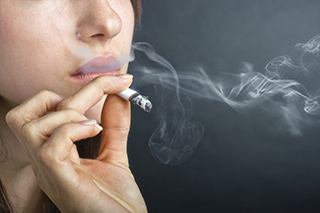What is secondhand smoke?
Secondhand smoke (also called environmental tobacco smoke, involuntary smoke, and passive smoke) is the combination of “sidestream” smoke (the smoke given off by a burning tobacco product) and “mainstream” smoke (the smoke exhaled by a smoker) (1–4).
People can be exposed to secondhand smoke in homes, cars, the workplace, and public places, such as bars, restaurants, and recreational settings. In the United States, the source of most secondhand smoke is from cigarettes, followed by pipes, cigars, and other tobacco products (4).
The amount of smoke created by a tobacco product depends on the amount of tobacco available for burning. The amount of secondhand smoke emitted by smoking one large cigar is similar to that emitted by smoking an entire pack of cigarettes.
How is secondhand smoke exposure measured?
Secondhand smoke exposure can be measured by testing indoor air for nicotine or other chemicals in tobacco smoke. Exposure to secondhand smoke can also be tested by measuring the level of cotinine (a by-product of the breakdown of nicotine) in a nonsmoker’s blood, saliva, or urine (1). Nicotine, cotinine, carbon monoxide, and other smoke-related chemicals have been found in the body fluids of nonsmokers exposed to secondhand smoke.
Does secondhand smoke contain harmful chemicals?
Yes. Among the more than 7,000 chemicals that have been identified in secondhand tobacco smoke, at least 250 are known to be harmful, for example, hydrogen cyanide, carbon monoxide, and ammonia.
At least 69 of the toxic chemicals in secondhand tobacco smoke cause cancer (1, 5, 6). These include the following:
- Arsenic
- Benzene
- Beryllium (a toxic metal)
- 1,3–Butadiene (a hazardous gas)
- Cadmium
- Chromium (a metallic element)
- Ethylene oxide
- Nickel (a metallic element)
- Polonium-210 (a radioactive chemical element)
- Vinyl chloride
Other toxic chemicals in secondhand smoke are suspected to cause cancer, including (1):
- Formaldehyde
- Benzo[α]pyrene
- Toluene
Many factors affect which chemicals are found in secondhand smoke, such as the type of tobacco, the chemicals added to the tobacco, the way the tobacco product is smoked, and, for cigarettes and cigars, the material in which the tobacco is wrapped (1, 3, 4).
